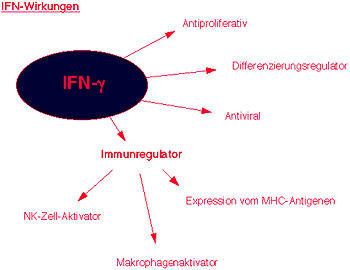Interferons are proteins and part of our immune system. They are only synthesized when induced by viral or other challenges. They are synthesized by specialized cells, subsequently secreted, and bind to highly specific receptors on target cells. This specific interaction with its receptors causes the signal transduction to the nucleus and thus regulates the production of about 50 different genes.
Therapeutic proteins: Protein design with interferons
IFN biological activities

Through their receptor binding Interferons act pleiotropic, meaning they mediate various biological activities like:
- antiviral, antiinfectious
- antiproliferative, cytotoxic
- immunomodulating
All these activities are of high pharmaceutical value as shown by several clinical applications in cancer and viral infections.
Classes of Interferons
There are three classes of interferons: 16 subgroups of Interferon-alpha, one Interferon-beta and one Interferon-gamma. The Interferons are relatively small proteins with 143 to 172 aminoacids ranging from 19 to 45 kDa. They are modified by glycosylation. Interferon-gamma is a homodimer while the others are monomers.
Clinical and Market Potential of Interferons
All Interferons are synthesized genetechnologically. The preferred system for the synthesis are bacterial cells. Interferon-alpha is used for oncological indications and for the treatment of viral hepatitis. The market value is about 1 billion US$. A similar value is expected for the next years for Interferon-beta for the treatment of multiple sclerosis. Much less used (so far) is Interferon-gamma, which helps in the treatment of the chronical granulomatosis disease, kidney cancer and rheumaticological diseases.
Example: Interferon-gamma
Interferon-gamma is a homodimeric protein with 143 amino acids. It is glycosylated on two asparagins. Its three-dimensional structure is meanwhile published. Interferon-gamma is less antiviral than the type I Interferons, but has much higher antiproliferative and immunomodulatory activities. It is synthesized in bacterial cells. Although they are not able to synthesize the glycosylation it seems to have no effect for the activities. Unglycosylated Interferon-gamma is a highly basic protein with an IP of about 10. In comparison to the type 1 interferons it is less pH-stable and with a Tm of 52°C shows a much lower thermostability.
For the reasons stated above several groups (including ours) have tried to generate a more stable or more active interferon through a modification of its DNA-code. Through shortening the C-terminus, a second generation Interferon-gamma was generated This new Interferon-gamma IFN-gamma-HA (high activity) is patented and now offered for further clinical development.
In the next step by rational protein design a third generation Interferon-gamma was generated. The specific incorporation of a disulfide bridge into the Interferon-gamma molecule resulted in a tightly packed IFN-gamma-HS (high stability) which shows an increased melting point of 70°C. This new Interferon-gamma is thouroughly characterized, patented, and now offered for further clinical development.
 Fraunhofer Institute for Interfacial Engineering and Biotechnology IGB
Fraunhofer Institute for Interfacial Engineering and Biotechnology IGB